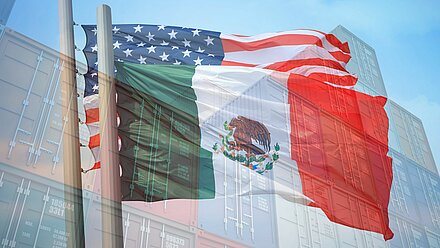Nearshoring continues to be one of the most talked-about supply chain topics, and executives who stay on top of best practices, considerations, and changes can retain a competitive advantage. McKinsey’s latest annual survey of supply chain leaders revealed that nearly two-thirds (64 percent) of respondents were taking steps to regionalize their supply chains, up from 44 percent in 2022, and 89 percent said they still want to reduce regional dependencies. While there are clear benefits to nearshoring, it’s not a panacea. Here are nearshoring benefits and considerations that all supply chain leaders should know.
Benefits
- Economic benefits – There are both short-term and long-term economic benefits to nearshoring. Container rate savings, fuel and transit cost reductions, reduced customs expenses, and cost-effective labor provide immediate returns on nearshoring investments. An experienced logistics partner can help supply chains benefit from the indirect economic benefits of faster market speeds, reduced waste and spoilage due to shorter transit times, and quicker problem-solving.
- Supply chain resilience – Ultimately, nearshoring is a resilience strategy as much as a cost strategy. Rather than being at the mercy of complex, far-away links in the chain, executives have greater control over the full spectrum of supply chain operations. Simplified and shorter supply chains reduce risks and allow companies to respond nimbly to changes, disruptions, or surprises. The convenience of being in the same time zone streamlines operations and can improve customer satisfaction through local service.
- Flexibility – Nearshoring gives companies flexibility beyond the trade border. For example, companies based north of Mexico can utilize various airports and ports across the U.S. to minimize supply chain disruptions from a weather event, strike, or other unforeseen circumstances. Importers/exporters with the flexibility to navigate multiple ports across Mexico and with the customs teams and brokers ready to manage the flow of goods will be able to avoid delays and prevent potential delivery issues before they start.
- Competitiveness – North American companies that nearshore or reshore to the Mexican border can gain a competitive advantage from Mexico’s labor force. On average, people in the supply chain workforce are highly skilled and educated and maintain reliable rates of quality production. The country has made significant investments in workforce training via technical schools to support manufacturing and supply chain operations.
- Sustainability – The environmental benefits of nearshoring are vast – they include lower carbon emissions, fewer capital resource requirements, and lowered risk of inventory damage or waste. Nearshoring strategies support supply chain companies’ ESG targets and satisfy the increasing number of customers exploring sustainable supply-chain options.
Considerations
- Switching costs – Shifting operations from one region to another entails upfront capital expenditures, retraining requirements, and potential interim disruptions. Of course, financial modeling and cost/benefit analyses can provide executives with information on the cost savings and ROI over time. The macroeconomic case for nearshoring is compelling, but there are exceptions to every rule.
- Timeframe - Depending on the degree of operational complexity, a nearshoring shift can take years to complete. Nearshoring may require companies to develop new locations – including manufacturing sites, warehouses, and/or ports. Supply chain logistics can go in cycles, and it’s essential to consider nearshoring a long-term, enduring strategy and not a response to a trend.
- Capacity – The rapid trade growth between the U.S. and Mexico has posed new questions. How much capacity can Mexico handle? Can the infrastructure and labor force keep up with demand? Can executives expect price stability, or will the costs of doing business with Mexico begin to rise as more and more companies make the shift?
Solutions
As a 3PL partner with global reach and nearshoring expertise, Gebrüder Weiss guides customers on nearshoring benefits and considerations. We make assessments and recommendations, provide insights on challenges, and if nearshoring is the right strategy, we help facilitate the change. From there, Gebrüder Weiss’ services can help customers overcome nearshoring obstacles, find suppliers, facilitate relationships and customs compliance, and maximize the economic benefits available.
Explore working with Gebrüder Weiss as your nearshoring partner. Contact us today.





